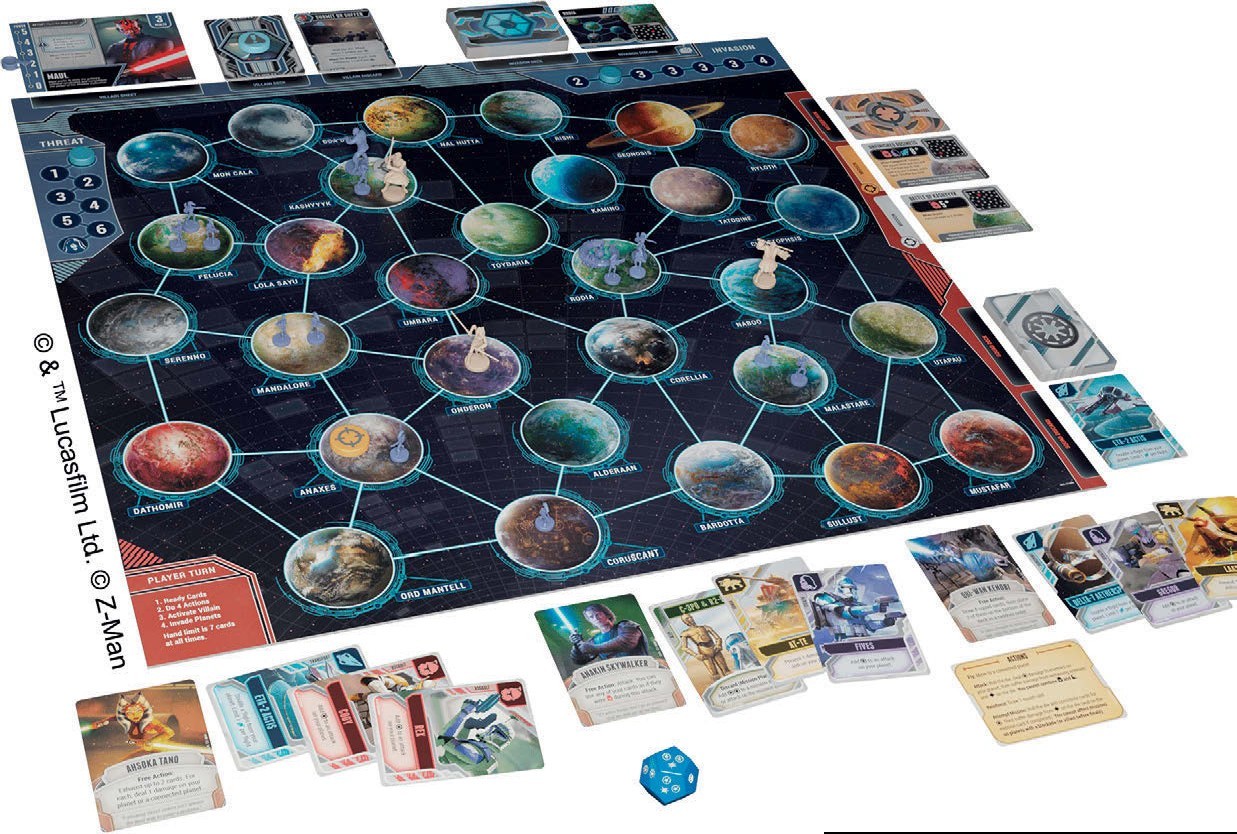Time to take the high ground
STAR WARS: THE CLONE WARS
Designer: Alexandar Ortloff & Matt Leacock | Publisher: Z-Man Games
Since its launch in 2008, Matt Leacock’s Pandemic has gone from being a ground-breaking co-op game to a genre in a box. Beyond its own expansions and remixes, it’s been re-themed for Lovecraft, floodfighting, the fall of the Roman Empire, World of Warcraft and 19th -century Iberia. In a sense, it’s surprising it’s taken so long for the “Pandemic System” (as it’s now branded) to reach a certain Galaxy Far, Far Away.
Anyone familiar with the clunky theme-slapping of, say, Star Wars Monopoly can be forgiven an eyeroll at this point. But don’t dismiss this latest Pandemic out of hand. Smartly drawing from the fan-favoured Clone Wars series rather than the patchy cinematic saga, this is a Star Wars reskin that goes more than reskin deep.
Pandemic’s core mechanism of dramatic, deck-based escalation translates well from disease outbreaks to battle-droid invasions. While the board’s planetary system doesn’t quite catch the eye like a good old-fashioned world map, you enjoy the same sense of things getting out of hand as all those wee droid miniatures start crowding up the planets, and your Jedi heroes (each with their own handy free-action power) have to carefully coordinate to deal with them.

But that’s not the only thing Obi-Wan, Anakin, Ahsoka and co. have to contend with. For a start, they have a number of missions to complete (how many depends on the difficulty level you choose). Then there’s a boss villain to fight, too. You can choose to one of four: sleek assassin Asajj Ventress; tubercular cyborg General Grievous; weirdly not-dead Darth Maul; or the formidable Count Dooku. Each has their own deck of troublesome villain cards (although there’s always one which will spark a horrible invasion), and their own finale, which is triggered as soon as all the missions are completed. Each one gives the game a distinctly different feel, in terms of the details of what’s happening, if not the overall mood.
At the lower difficulty levels, it will all be quite manageable for the experienced Pandemic player. Especially as chain-reaction-starting outbreaks don’t occur in this version of the game; instead of adding more droids to neighbouring worlds when a planet is full, you place a blockade. This must be removed via combat (handled by the roll of a chunky 12-sided die) before anything else – such as completing a mission – can be achieved on that world. The catch is, there are only three blockades, and the threat marker must advance along its potentially game-ending track if you ever can’t place one.
You also get a lot of help courtesy of your squad cards, which contain military support from clone troopers, armoured vehicles, journeyshortening starships and powerful allies. Most cards can potentially be retained for the duration of the game, forming a handy tableau whose powers can be repeatedly applied. However, if you take damage (and you will take damage), and can’t block it by exhausting armour cards, you’ll have to sacrifice some of this support.
This squad dynamic is particularly thematically pleasing, giving you the sense of each Jedi as a military leader who must sometimes make tough decisions to prevail against everincreasing odds.
DAN JOLIN
WE SAY
A neatly implemented blend of a slick, entertaining game system with a beloved theme. The miniatures are decent, too.
WHAT’S IN THE BOX?
◗ Game board
◗ Twelve-sided die
◗46 Squad cards
◗32 Invasion cards
◗7 Jedi cards
◗4 Villain sheets
◗24 Villain cards
◗24 Mission cards
◗7 Jedi miniatures
◗4 Villain miniatures
◗3 Blockade miniatures
◗36 Battle droid miniatures
◗2 Track markers
◗2 Mission markers
◗ Reminder marker
◗ Slider
◗5 Reference cards
◗ Solo marker
TRY THIS IF YOU LIKED WORLD OF WARCRAFT: WRATH OF THE LICH KING…
Designer Alexandar Ortloff’s last Pandemic System game feels closest to Clone Wars, though there are shades of Reign of Cthulhu in there, too.